Team Members : Mr. Udayashankar T M, Mr. Yathish Kumar A, Mr. Vasu M K, Ms. Reshma
Project Guide : Prof. Sheila H
Description:
An eco-friendly solution for domestic electrification applications using stored muscular energy in the gravitational potential energy.
Prolong the usage of stored muscular energy.
Generating significant amount of power for domestic application
This is a boon for developing nations where a large number of people still use fuel based lighting sources
The invention has been made keeping in mind the energy crisis and the cost involved in alternate forms of energy such as solar energy devices
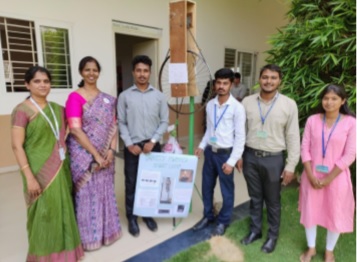
Team Members :Mr. Vishal Malkani, Mr. Yashas, Ms. Niriksha M, Ms. Priyaa M L
Project Guide : Prof. Sheila H
Description:
Fast and safe charging systems that do not damage the batteries
Improved fast-charging technologies EVs will be charging at rates of >100 kW.
Safely charges an EV battery in 5–10 min
Bidirectional power flow
Achieve resonance for maximum efficiency
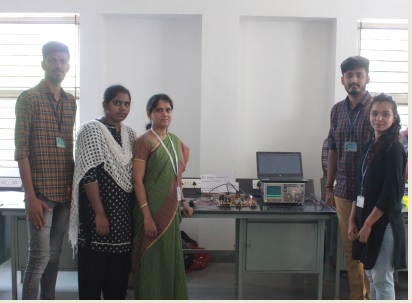
Team Members :Mr. Devraj, Mr. Thippeswamy J, Mr. Kumar M K
Project Guide :Dr. Surekha Manoj
Description:
The automation of flood gates implemented in water control system ensures to avoid wastage of water and reduces time consumption.
Automatic operation of gates and faults can be easily detected. It detects the level of water and estimate the water outflow in a dam.
Controlling level and flow of water with real time implementation
It can be best implemented in isolated and hazardous locations.
Awarded as best project in aavEEEshkar -2019 and Won Prize in Project Competition held at ATME, Mysore- 2019
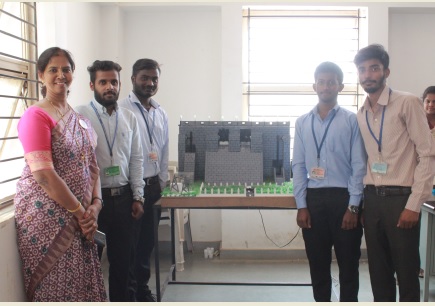
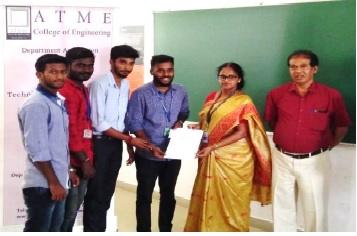
Team Members :Mr. Mohan Aradhya A R, Mr. Kiran Kumar H S, Mr. Kiran Kumar H S
Project Guide :Dr. Surekha Manoj
Description:
Swachh bharat slogon has motivated to use plastic for energy generation
Increase in energy demand and depletion of oil resources have made to find alternative fuels for internal combustion engines
Waste plastic pose a very serious environment challenge because of their disposal problems all over the world.
Waste plastic solid is currently receiving renewed interest. The oil derived from waste plastics were analyzed and compared with the petroleum products and found that it has properties similar to that of diesel.
This project is a social benefit has been made the conversion of waste plastic into liquid fuel by using pyrolysis process.
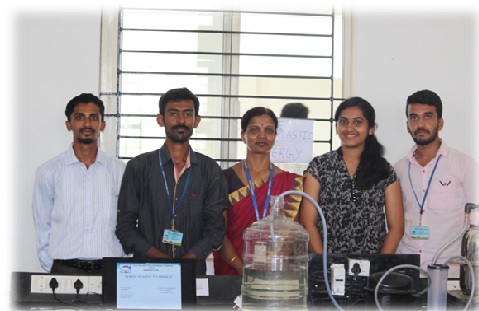
Team Members :Mr. Mahesh Kumar, Mr. Mohith B N, Ms. Neelambika K S, Mr. S Vijay
Project Guide :Dr.P S Kiran Kumar
Description:
To understand the operation of a 33KV substation
It is a system which provides the testing platform for overvoltage protection, unscheduled load shedding and time based load shedding
PLC and SCADA systems are used to monitor and control the substation model
Received 1st prize in aavEEEshkar - 2018
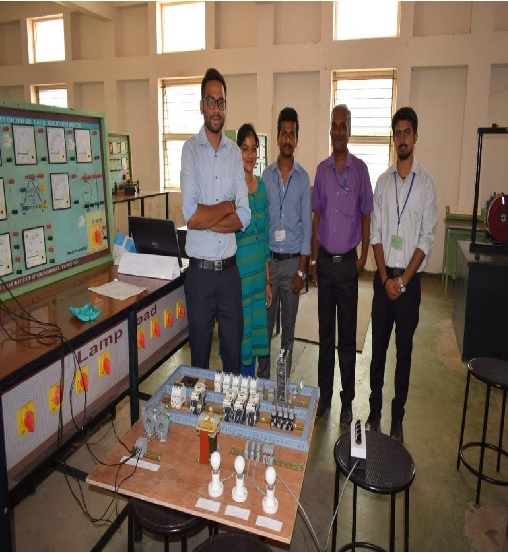
Team Members :Mr.Jalendra M R, Mr.Suresh Naik, Mr.Varun V , Mr.Saifuddeen A
Project Guide :Dr.Shamala N
Description:
Due to the ending stocks of fossil fuels this project can be used as Alternative sources of energy
Energy generated is Supportive for developing countries where enormous amount of availability of Hydrogen
This simple technique of using hydrogen as fuel is a very economical
This is the basic idea of our project. Finding new ideas for developing in power sector is the main motto
Solution for Social and domestic benefiting project

Team Members :Ms. Niveditha T V , Mr. Raghav K R , Ms. Shivani N, Mr. Diwakar K R
Project Guide :Dr. Surekha Mannoj
Description:
High altitude wind energy is currently a very promising resource for the sustainable production of electrical energy.
The amount of power & winds that blow between 300 and 10000m from the ground suggest that Airborne Wind Energy Systems (AWESs) are an important emerging renewable energy technology.
Harvesting clean energy from an endless source, Buoyant Airborne Turbine is the Next Generation of Wind Power.
They are portable for off-grid, remote areas & isolated communities i.e, oil & gas mining, disaster relief organizations; and military bases etc
Got selected for Karnataka State Council for Science and Technology (KSCST) and sponsored in the year 2018-19
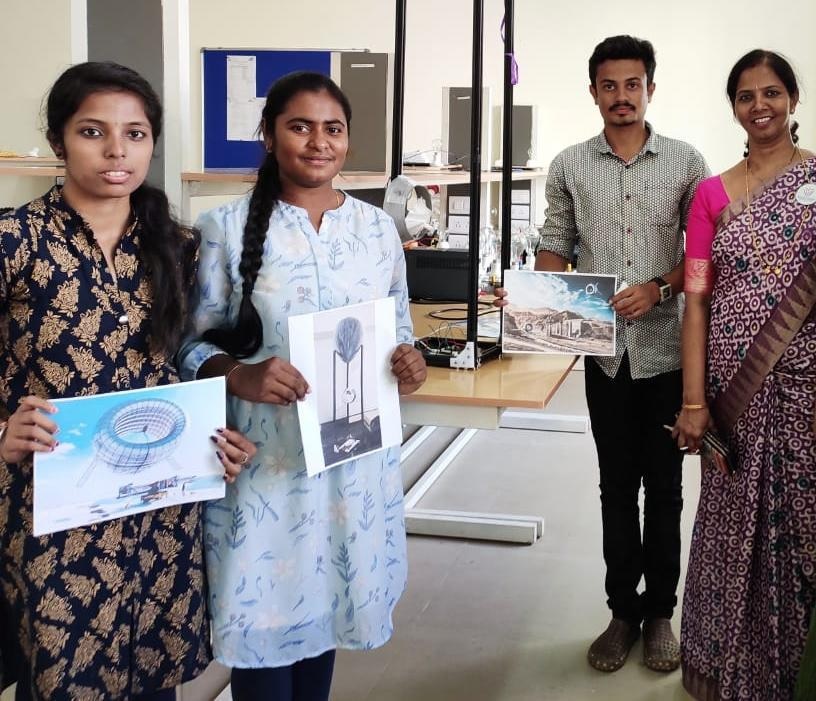
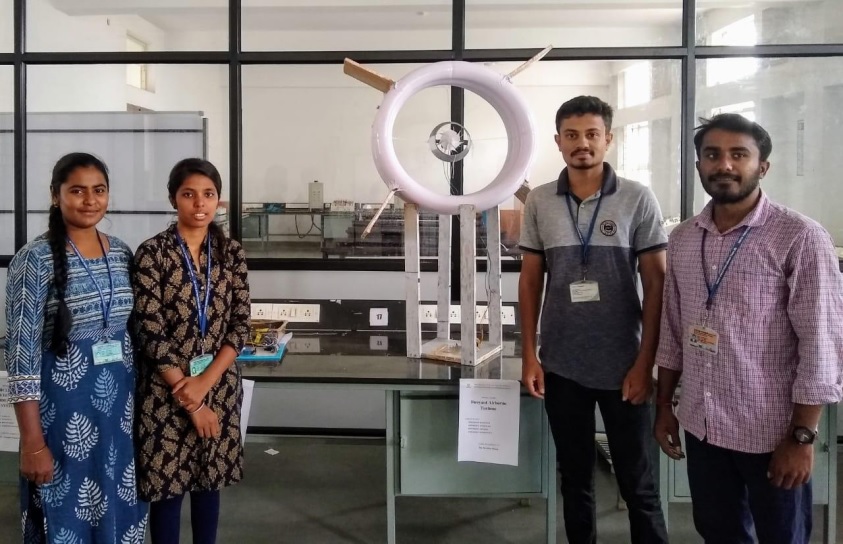
Team Members :Ms. Anjali Iyear S, Ms. Manasa S Hosur
Project Guide :Prof. Manjunatha B
Description:
The government provides bicycles to the school students. But to the students in remote areas pedaling cycle in terrain region is a difficult task to reach school as the distance would be minimum 3-5 km.
This project work aims at resolving this problem. The current solution for this issue is that if there could be a scheme under which students who live far of places are given with low cost electric bicycles. But this concept should not burden on government as it would be costly affair. It is also difficult to charge the electric bicycles because of insufficient power supply in the remote areas. So to overcome the above problems this project work has planned to design a regenerative electro mechanical – bicycle.
The charging of battery for the vehicle and installation of gearbox for the regenerative electro mechanical – bicycle are the important areas. Charging of bicycle can be done from different sources
Charging through the regenerative energy through solar panels which are placed in school.
It has more flexibility over other electric vehicles as charging of the battery can be done while pedaling.
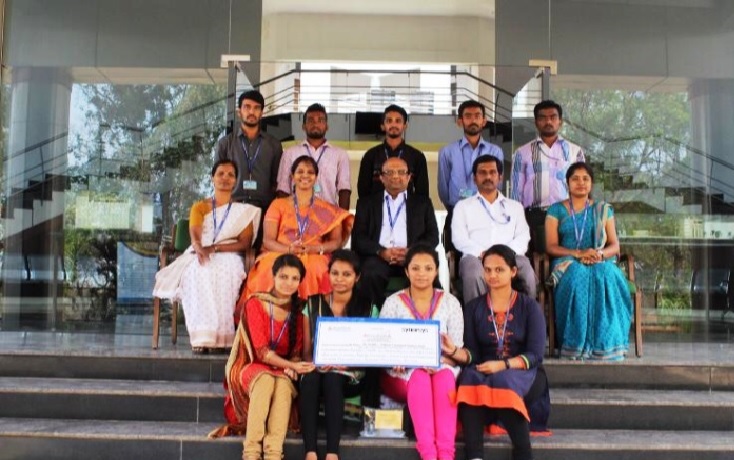
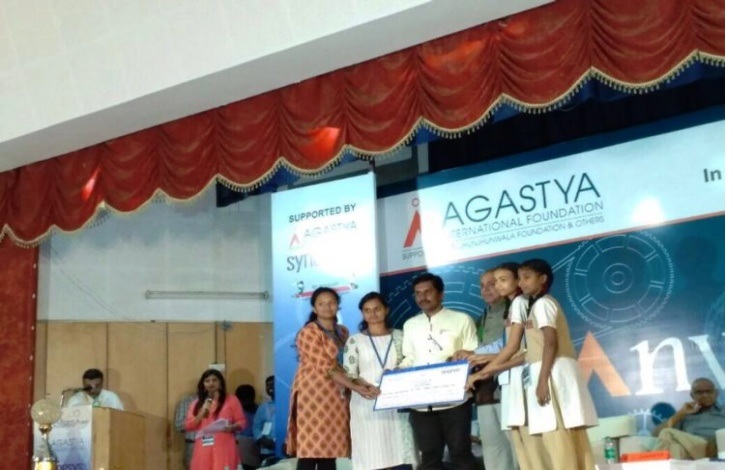
Team Members :Mr. Abhishek H N, Mr. Abhishek Maiya, Mr. Chethan R, Ms. Meghana C G
Project Guide :Prof. Kaveri K B
Description:
This project gives a sensible approach towards the highway street lights.
The power consumption will be reduced by efficient utilization of renewable sources for the application of street lightening based on the automobile movement.
Using IR sensor vehicle movement is sensed and brightness of street light is increased, after it passes the streetlight pole again brightness in decreased.
LDR is used to detect the day light
The project was presented at SWITCH program conducted by Gujrat Government
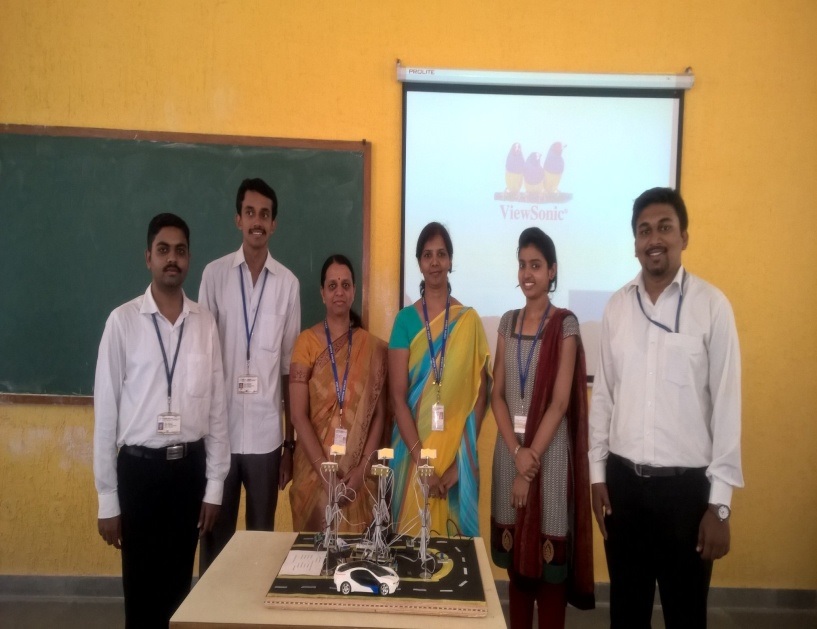
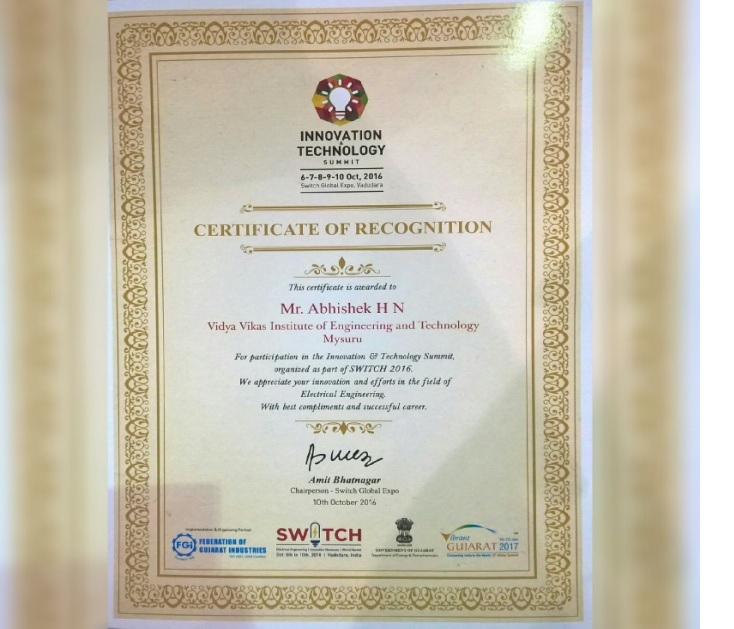
Team Members :Ms. Sakshitha H N , Ms. Sanchitha S, Ms. Sindhu M S, Ms. Sowmya A
Project Guide :Prof. Zuhaib Baig
Description:
This project contributes to the self-dependency of physically challenged and older people
The use of voice commands eliminates the need to remote controllers and other electronic device and makes it easy to interact with the system to perform automation and control electrical devices.
The systems find use not only in houses but also in hospitals where appliances such as fans or lights on multiple floors can be controlled by a person thereby saving time.
An adjustable bed fitted with motorized jack is modelled rather than building a mechanical base with linear actuators which is proven to be very economic
Got selected for Karnataka State Council for Science and Technology (KSCST) and sponsored in the year 2016-17

Team Members :Ms.Sahana S Desai,Ms.Ranjana K R, Ms.Anjali Iyear S, Ms.Nivya K M
Project Guide :Prof. Sowmya G
Description:
In a time of electronics, the losses due to its inherent phantom load have grown in significance. Phantom load is defined as the power consumed by a device when it is not in active use but still plugged into the mains.
Many of the home appliances in homes today consume power when they are turned off. These include microwaves, stereos, VCRs and television sets. The phantom load can be caused by influences in converting AC into DC electricity, by indicator lights like clocks on VCR’s or by standby power use such as that used for electronic memory or remote.
While the power consumed from a single unit may be small, it has become typical for an average household to possess several devices that are idle for any given period of time.
This results in unnecessary costs for both the household and the utility provider. Thousands of rupees can be saved each year if the owner of the devices does one thing: turn the power off.
This project was awarded as best project in the project exhibition conducted by GSSSIETW and MIT, 2018


Team Members :Ms. Nivya K M, Ms. Gayana Thammaiah, Mr. Varun V, Mr. Tathagath Chakraborthy
Project Guide :Dr. Surekha Manoj
Description:
"Smart Eye" Project Made By the Final Year Students Which Helped The Visually Impaired As A Real-Time Assistance, Published In National Journal (2017-18).
This Project was selected for AICTE-ECI, Chhatra Vishwakarma Award Finals, held on 19th September 2017, at AICTE Headquarters, New Delhi.
This project is an innovative idea of intelligent system which has basically two features the first one is Obstacle detection and the second one is providing accurate location and position through GPS. It will provide safety and support to visually impaired Persons.
This results in unnecessary costs for both the household and the utility provider. Thousands of rupees can be saved each year if the owner of the devices does one thing: turn the power off.
This project was awarded as best project in the project exhibition conducted by GSSSIETW and MIT, 2018

Team Members : Bhuvana M, Anusha Robert, Akshay Pattar, Amit A Patil
Project Guide : Dr. Shamala N
Aim :To develop Vocalized Auto ROBO for Physically Disabled
Objective : Objective is to build a smart wheel chair which would have a sort of intelligence and helps the user on his/her movement
Abstract of the project:
This project pays to the self-dependency of physically challenged, handicapped and paralyzed and older people. It reduces the manual effort for a attaining and distinguishing the command for controlling the motion of a wheelchair by specified commands
Team Members : Pancham S, Rakshith K, Praveen B M, Shridar M Joshi
Project Guide : Mr. Manjunatha B
Aim :To design and develop Biometric Based E- Voting System
Objective : The objective of project is to design a system that asks the user to show his Finger print as an identity proof.
Abstract of the project:
This project proposes a secure online e-voting system that uses UIDAI or Aadhar based as its Backend the system ensures the authentication of an individual by matching fingerprints and eligibility is checked by calculating the age of voter thus making the existing voting card redundant
Team Members : Chandana B N, Anusha C V, Darshan R, Karthik S D
Project Guide : Mrs. Jayashree M
Aim :To develop Bidirectional power flow control in DC microgrid through switched Capacitor cell using Hybrid DC-DC converte
Objective : To design convter efficiency
Abstract of the project:
This project develops a bidirectional power flow control using a hybrid DC-DC converter with switched-capacitor cell. The converter connects a low voltage DC bus to a high voltage DC bus, allowing bidirectional energy transfer, and smooth transition between the step-up and the step-down mode

Team Members : Gowri G V, Chaithra M S, Anusha S, Maheshwari B
Project Guide : Ms. Suma S
Aim :To develop Solid Waste Management Using Internet of Things
Objective : To avoid over flow of garbage and to keep the environment clean
Abstract of the project:
The garbage bin are effectively monitored by the internet of things(IOT) ,thus assures the cleaning of garbage bins. When the garbage reaches its maximum level, then SMS will sent to the predetermined phone number to clean the bin so that regular maintenance of the garbage can be done

Team Members : Krupavathi S P, Neelesh A R, Narashima Murthy M, Vinutha M C
Project Guide : Mr. Karthik R P
Aim :To design and develop a novel strategic controller for dual axis solar tracking
Objective : Design a system that tracks the solar UV light for solar panels and Panel rotating 360 degree vertically
Abstract of the project:
Dual axis tracker perfectly aligns with the Light direction and tracks the Light movement in a more efficient way and has a tremendous performance improvement
Team Members : Chandra Mouli H M, Cyril C, Arjun R, Sharath V
Project Guide : Mrs. Sowmya G
Aim :This project is aimed at reducing the heavy power and revenue losses that occur due to power theft by the consumers.
Objective : The main objective of the project is to develop a wireless energy meter. Real-time Power monitoring at houses. Sensing the power theft. And transmitting the information over wireless to substation. By sensing current flow through the line & energy feedback we can prevent theft using a circuit breaker.
Abstract of the project:
Electrical power theft is a major problem in power system network all over the world which is illegal and should be strictly prohibited and detection will help the utilities to improve the reliability, security and operation of power network. This also contributes in revenue for the government and betterment of society
Team Members : Bharath N, Karthik B K, Kiran M K
Project Guide : Mrs. Kaveri K B
Aim :Automatic Bus Fare Collection
Objective : To make passenger smooth and cashless travel.
Abstract of the project:
RFID Card will be issued , so that passenger can swipe while boarding to the bus. The currency availability will be also addressed appropriately

Team Members : Deepika G, Anusha S, Chandan S, Chandankumar A C
Project Guide : Mrs. Sowmya G
Aim :To develop a system which will provide a non-interrupted power supply to the energy consumers.
Objective : The microcontroller based load sharing and control system is a device that automatically controls overload on a generator by sharing power and cut off supply once the power consumption exceeds the amount of power supplied.
Abstract of the project:
Load Sharing system enables automatic control of overload on a generator by sharing power and cut off supply once the power consumption exceeds the amount of power supplied
Team Members : Chandan S, Sharath N P, Mohankumar S, Harshitha Gowda M P
Project Guide : Mr. Surender Kumar S
Aim :To develop a method of accident detection that is efficient .
Objective : vehicle theft detection, vehicle glare problem and develop android control ignition
Abstract of the project:
The project is provide an optimum solution for the vehicle theft and road accident. The accident alert system is one such system which can alert the relatives and the emergency services about the accident and thus save valuable life

Team Members : Darshan P C, Dileep C, Harshith V Gupta, Navade Nishant
Project Guide : Mr. Hemanth Kumar K
Aim :To design and develop Ion Energy Generators.
Objective :To meet Green energy production
Abstract of the project:
The act of harvesting the electric charge from atmospheric ions harmlessly reverts the ions back to their original state of neutral atoms. The former ions, now neutral atoms, are once again free to migrate through the atmosphere – available to be converted back into electrically charged ions by natural processes. Ion harvesting results in the generation of clean, natural, renewable energy that will not pollute Earth.
Participated in Technical Project Compition conducted by ATME, Mysuru

Team Members : Anil Choudary, Jagruth S J, Tejas M, Preetham S P
Project Guide : Mrs. Ganavi C N
Aim :To design 3Xs Engraving and Milling of PCB
Objective :To develop a low cost automatic mini CNC machine for PCB drawing and drilling. This system reduces the cost of machine and increases the flexibility
Abstract of the project:
A low cost CNC machine which is capable of producing PCB with high precision and also which has the function to wirelessly monitor and control the operation is developed.

Team Members : Chaithanya H M, Divyashree N, Shobha M M, Sushma T
Project Guide : Mr. Yathish Babu A M
Aim :To design Google Assistance Based Robotic Arm For Disabled People
Objective :To provide commands to the Google assistance which converts voice to text and sends to arm and arm do the operations as per the voice commands.
Abstract of the project:
A smart robotic assistance that will work according to voice commands and gesture commands. The voice and gesture commands are converted to text from and arc transmitted to the board from there its moved to the corresponding motors, then the wheels are rotated.

Team Members : Sandesh B Bangre, Sanjay Kumar, Siddesh N, Suhas H B
Project Guide : Dr. Shamala N
Aim :To develop Eco-Friendly Smart Toll Gates
Objective :The objective is to avoid fuel loss, save time and monitor traffic
Abstract of the project:
By doing automation of toll plaza we can have the best solution over money loss at toll plaza by reducing the man power required for collection of money and also can reduce the traffic indirectly resulting in reduction of time at toll plaza.

Team Members : Devaraj, Kumar M K, Thippeswamy J, Thushar M S
Project Guide : Dr. Surekha Manoj
Aim :To design Flood Gates Control Using Programmable Logic Controller
Objective :To control and monitor the water level in the dam to avoid flood condition
Abstract of the project:
By developing an automated flood gates by use of PLC method makes the system both power and cost- effective and also easy to be operated and maintained. Direct gate control using weather forecasts and satellite implications can be done. This would help make the system a lot more efficient and robust by upgrading its response to sudden situations like cloudbursts or floods.

Team Members : Arbin Sultana, Apoorva L P, Adarsh K, Amruth M
Project Guide : Mrs. Varsha V
Aim :To Design and implement advanced Energy Monitoring System
Objective :The primary objective of the Smart Meters is to reduce the energy consumption in the households.
Abstract of the project:
The versatile use of smart meter in smart grid scenario is great and to be employed in order to meet the consumers objectives in terms of monitoring and control of power consumption and it detailed feedback for billing , saving energy, monitor the load demand by demand side management programs, home energy management system which are been explored.The smart meters are interfacing with the house hold appliance, to know the each appliance power consumption and to save the power by inter coordination between the home appliance

Team Members : Pooja M S, Shilpashree M, Srilakshmi B G, Sushma J
Project Guide : Mrs. Swathi K
Aim :To develop Eco friendly pest control system
Objective :Objective is to reduce the use of chemical pesticides which are adversely effecting the crops and mankind
Abstract of the project:
Automation system is the technical approach in which the farmers in the rural areas will be benefitted by automatic monitoring and control of field environment. It replaces the direct supervision of the human. It also focuses on the generic architecture which can be applied for much other automation application.

Team Members : Abubakar Siddique S, Rakesh C R, Harsha L, Monisha D
Project Guide : Monisha D
Aim :To develop Women Safety Device with GPS tracking & alert
Objective : To reduce probability of women becoming a victim of violent crime
Abstract of the project:
This device consists of a system that ensures dual alerts in case a woman is harassed or she thinks she is in trouble.

Team Members : Vinutha K, Supritha S, Thejaswini Reddy M, Mallesh H
Project Guide :Mr. Kiran Kumar P S
Aim :To Develop IOT Based Patient Health Monitoring System
Objective :The main objective is to design a Patient Monitoring System with two-way communication
Abstract of the project:
Development of a module that provides mobility to the doctor and the patient, by adopting a simple and popular technique, detecting the abnormalities in the bio signal of the patient in advance and sending an SMS alert to the doctor through Global System for Mobile(GSM) thereby taking suitable precautionary measures thus reducing the critical level of the patient.

Team Members : Manikantan K, Karthik S, Guruprasad K P, Kamaran D M
Project Guide :Mrs. Kavyashree S
Aim :Is to Design and develop 3D prototype printer ,compliable technology
Objective :The main objective is to design a Patient Monitoring System with two-way communication
Abstract of the project:
By using this setup with a combination of G-code Arduino software for smooth operation and give better accuracy for design.

Team Members : Vishal Malkani, Yashas, Niriksha M, Priyanka M L
Project Guide :Mrs. Sheila H
Aim :To design and develop Fast Charging Technique For Electric Vehicle
Objective :To design a controller which can achieve the constant current-constant voltage (CC-CV) is developed for the grid tied CHB converters
Abstract of the project:
The proposed technique can control the average current which is applied to each cell of the converter. Also, an estimationtechnique is proposed which does not need to use the opencircuit voltage/SOC characteristics to estimate the parametersof batteries

Team Members : Tamraparni Gouri, Sandeep M Prasad, Pavan H P,Sushma M A
Project Guide : Sushma H S (Asst. Professor Dept. Of Eee)
Abstract of the project:
In power systems, distribution transformer distributes power to the low-voltage users directly. As it connects with the consumers and because of its continuous operation the efficiency and reliability of such transformers is very much essential and hence protection of transformers should be given much of importance. Power system engineers must balance the expense of applying a particular protection scheme against the consequences of relying on other protection or sacrificing the transformer.
The proposed design and implementation of a mobile embedded system to monitor and record key operation indicators of a distribution transformer like transformer oil and ambient temperatures. This on-line monitoring system integrates a Global System for Mobile communication (GSM) Modem, with stand-alone single chip microcontroller and sensor packages.
The GSM based monitoring of distribution transformer is quite useful as compared to manual monitoring and also it is reliable as it is not possible to monitor always the oil level, ambient temperature rise, load current manually. This GSM based monitoring of service transformer enables the personnel to curb the abnormalities before they lead to hazardous failures. It improves the reliability and shelf life of the distribution transformer After receiving the message of any abnormality operators can take action immediately to prevent any catastrophic failures of distribution transformers.
Cost of the project: Rs.8,000 /-
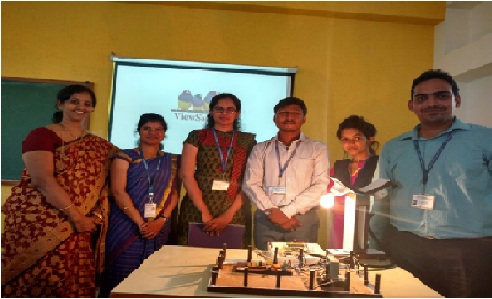
Team Members :Mohammed Haroon Saleem, Ravi Kumar Gupta, Sharath Anand H S, Sukanya B
Project Guide : Smt. Sowmya G Assistant Professor
Abstract of the project:
A major problem today for Vehicle owners is that they are in constant fear of having their vehicles stolen from a common parking lot or from outside their home. Microcontroller based real time vehicle theft detection and prevention system provide an ultimate solution for this problem. Research has shown that every day more than 17 vehicles are stolen from a state. This makes it a necessity more than ever to have a protective system to our vehicles with a stolen vehicle recovery system that is reliable and effective.
The main scope of this project is to send an alert message to authorized owner of the car when the vehicle is stolen. The project includes a Global System for Mobile communication (GSM) module, microcontroller, Global Positioning System (GPS), buzzer and a vibration sensor to detect vehicle theft. When someone tries to steal the car then microcontroller gets an interrupt and orders GSM Modem to send the Short Message Service (SMS), the owner receives a SMS that his car is being stolen through GSM Modem.
The aim of this project is to use wireless technology to intimate the owner of the vehicle about any unauthorized entry. This is done by sending an auto-generated SMS to the owner. The owner receives the SMS that his Vehicle is stolen. This system is also integrated with a GPS module which helps in tracking the vehicle. This SMS contains the details about the latitude and longitude coordinates of the vehicle. By entering these values in Google Maps, one can easily locate their vehicle.
Cost of the project: Rs.5,000/-
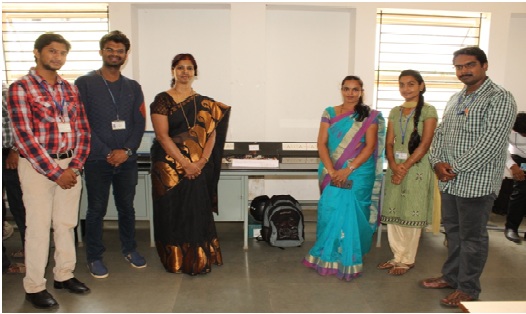
Team Members : Anthony Thomson D, Meghana R, Naveen Kumar K
Project Guide : Sri. P.S.Kiran Kumar Assistant Professor
Abstract of the project:
In the recent times we are constantly hearing about petrol bunk frauds. Most of the petrol bunks today have manipulated the pumps such that it displays the amount as entered but the quantity of fuel filled in the customer’s tank is much lesser than the displayed value. The pumps are tampered for the benefit of the petrol bunks owner. This results in huge profits for the petrol bunks but at the same time the customers are cheated. Almost all the vehicles in India consist of analog meters hence it is not possible to precisely know the amount of fuel currently in the vehicle and also it is not possible to cross check the quantity of fuel filled in the petrol bunk. This project focuses on creating a digital display of the exact amount of fuel contained in the vehicles tank and also help in cross checking the quantity of fuel filled at the petrol bunk. Also fuel filling logs are stored in order to verify the performance of the vehicle, over a period of time.
Cost of the project: Rs.4,000/-
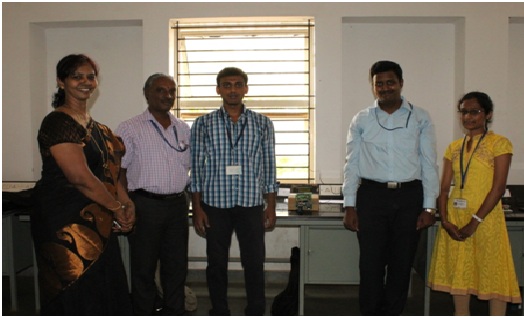
Team Members : Abhishek H N, AbhishekMaiya, ChethanR, Meghana C G
Project Guide : Kaveri K B Associate Professor
Abstract of the project:
Traditionally, city street lighting in India has not been designed, operated or maintained very efficiently. The actual consumption for public lighting in India is 7,753 GWh. However, according to available data, electricity consumption for public lighting systems is increasing at a rate of 10% (compared to an overall increase in India's electricity consumption of 7%).
This project gives a sensible approach towards the public lighting system i.e. street lights or highway lights which will be kept switched ON for the whole night despite of fewer traffic. This wastes a huge amount of energy as there millions of public lights to light the highways. This project presents how this wastage can be minimized by keeping the light’s brightness to only 30% using advanced sensor technology and embedded system which saves average of 60% of electricity by this Smart highway we can save approximately 116MW of energy for a year in a 1km stretch highway thereby making it more promising project to invest on considering the economic aspect compared to other energy producing projects.
Monitoring of street lights and controlling is of utmost importance in developing country like India to reduce the power consumption. The aim of this project is to develop a system which is a remote streetlight monitoring and controlling system based on LED and wireless sensor network. The system can be set to run in automatic mode, which controls streetlight. This control can make a reasonable adjustment according to the seasonal variation. Also this system can run in controlled mode. In this mode, we can take the initiative to control streetlights through PC monitor terminal. This street light system also includes a time cut-out function and an automatic control pattern for even more electricity conserving, namely when vehicles pass by, the light will turn on automatically, later turn off.
Cost of the project: Rs.6,000 /-
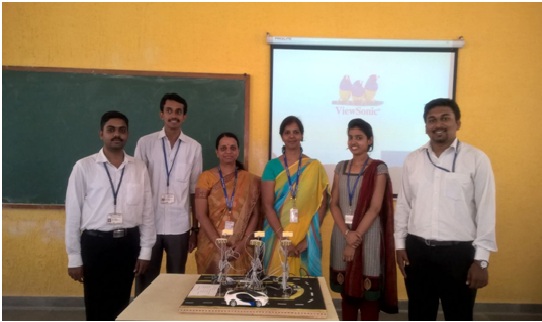
Team Members : G.Divya, Inchara .N T, Lakshmi Pramod .P, Kiran .G
Project Guide : Smt Sheila H Associate Professor
Abstract of the project:
In the field of agriculture, use of proper method of irrigation is important because the main reason is the lack of rains & scarcity of land reservoir water. The continuous extraction of water from earth is reducing the water level due to which lot of land is coming slowly in the zones of un-irrigated land. Another very important reason of this is due to unplanned use of water due to which a significant amount of water goes waste.
For this purpose in this proposed project, automated irrigation system. The system derives power from solar energy through photovoltaiccells when main supply is not available. Hence, dependency on erratic commercialpower is not required.
In this proposed system project utilize the solar energy from solar panels when mainpower supply is not available to automatically pump water and to irrigate the lands dependingon the intensity of sunlight. This saves substantial amount of energy and efficient use ofrenewable energy. In this system we use a soil moisture sensor that detects the amount ofmoisture present in the soil and depending upon the requirement of level of moisture contentrequired for the crop the water flow is regulated thus, conserving the water by avoiding overflooding of crops.
Automated Irrigation System on Sensing Soil Moisture Content project comprisesthree main components namely microcontroller, moisture sensor and relay. This project usesPIC microcontroller which is programmed in Atmel software. The sensor arrangement sensesthe moisture of the soil and waters accordingly. In Irrigation as individual crop contains different types of water levelrespectively, hence we have made the project for 3 different types of fields with differentMoisture levels with moisture sensors, thus encouraging farming in India and same timegiving a solution for energy crisis and water conservation.
Cost of the project: Rs.5,000 /-
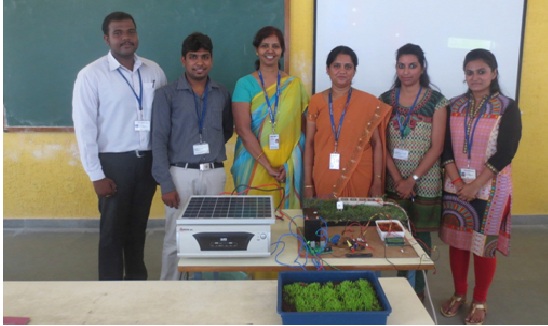
Team Members : Divyashree K, Rashmi K V, Nagendra M, Tejaswini A
Project Guide : Hemanth Kumar S ,Assistant Professor.
Abstract of the project:
Stuttering is a speech disorder which is affecting millions of people in their day to day life. Stuttering is a complex speech problem which affects the verbal communication. A mobile robot is built, which can be controlled by the user by employing the voice commands such as, ‘Go’, ‘Left’, ’Right’ and ‘Back’ issued by the user. The robot will identify the voice commands even if they are stuttered. This work can be used to upgrade speech recognition systems.
Voice Controlled Robot (VCR) is a mobile robot whose motions can be controlled by the user by giving specific voice commands. The speech is received by a microphone and processed by the voice recognition module. When a command for the robot is recognized, then voice recognition module sends a command message to the robot’s microcontroller. The microcontroller analyses the message and takes appropriate actions. The objective is to design a walking robot which executes its action through geared DC motors.
When any stuttered voice commands are given to the microphone, the Voice Recognition module will take the analog voice commands and convert the voice commands into digital signals. The Hardware implementation part used here is ATmega 328 microcontroller. The speech recognition circuit functions independently from the robot’s main intelligence. The software part is done in Arduino UNO using Embedded C.
The project aim is to design a voice controlled unmanned vehicle which is able to recognize the stuttered speech by implementing sequence training technique. A novel method of employing the DTW algorithm for feature matching has been implemented where the matched features generate the corresponding function key.
Cost of the project: Rs.5,000 /-
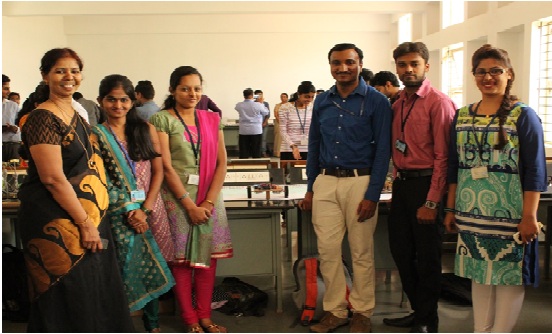
Team Members :Ravikumar B.P, Rashmi A, Rajashree, Vikalpa H.S
Project Guide : Dr.Sureka Manoj Professor & Head, Ms. Ganavi C.N Assistant Professor
Abstract of the project:
This project presents a concept to provide a smart electronic aid for blind people.This project focuses on to improve visually impaired person’s mobility. New technologies are incorporated to solve such issues like; detect obstacles, pit, stand still water and finding location.The proposed system is based on Global Positioning System (GPS) and Obstacle detection and object avoidance technologies .The aim of the overall system is to provide a low cost and efficient navigation aid for blind which gives a sense of smart vision by providing information about the environment scenario of static and dynamic object around them.
Cost of the project: Rs.6000 /-
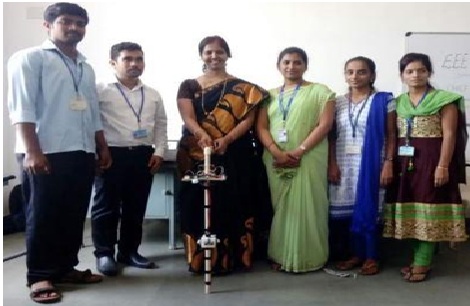
Team Members : Supreeth, Sunilkumar, Madhumathi, Sindhu
Project Guide : Sri Chandrashekar P, Assistant Professor
Abstract of the project:
The main theme of this project is utilization of industrial waste emerging out through chimneys in the form of heat. The principle used is “Bottoming cycle”. The excess heat from a manufacturing process is used to generate steam, and this steam is used to generate electricity. No extra fuel is required to produce electricity, as fuel is already burnt in production process.
The main aim of this project is to generate electricity locally available resource to utilize for local areas. Even though large amount of power cannot be generated, its ample enough to run lighting system which reduces the energy consumption significantly.
This work also helps the end users and also low load consumers. Usually due to large power demand in industries bulk amount of power is supplied to them ignoring low load users. So to overcome this imbalance it is necessary that the industries generate power locally through various resources available within.
The project aims to generate power only using the already available resources and renewable sources. Since there is no combustion of fuel, it is eco-friendly and does not pose any threat to the environment
To conclude that by installing this project work in large industries the power demand can be decreased significantly and also end and low load consumers get ample power for their use.
Cost of the project: Rs.7,000 /-

Team Members : Ms. Swathi R, Ms. Swetha K, Ms. Usha Nagaraj, Ms. Vidya S K
Project Guide : Dr. Surekha Manoj, Professor & Head Department of Electrical & Electronics Engineering
Abstract of the project:
Due to the ending stocks of the fossil fuels as well as instability of the political situation in the world, especially in countries which are major crude oil suppliers, governments of countries that are poor in the resources are forced to seek alternative sources of energy. Currently, the most common fuel for admission of internal combustion engine is oil. As a result of the continuous increment of fuel prices and to decrease the toxic exhaust gas emissions, tends to expand the power base of the automotive industry through the introduction of alternative fuels. One of them is fuel which is derived from renewable energy sources. These include gaseous fuels like biogas, hydrogen gas and its mixture.
This project includes description of hydroxy generator and verification of the desirability of enrichment in hydrogen and oxygen gaseous fuels used to supply internal combustion engines. Brown’s gas (HHO) has recently been introduced to the auto industry as a new source of energy. The present work proposes the design of a new device attached to the engine to integrate an HHO production system with the gasoline. Performance analysis and emission analysis has been done by using petrol and petrol HHO separately on engine. It has been found that around 20% reduction in fuel consumption is achieved by using petrol HHO and appreciable amount of reduction in emission of pollutants such as CO, unburned hydro carbons and carbon dioxide particularly during the idle condition. In the design of Hydroxy Generator project it is proven that increase in fuel efficiency with additional power. The hydrogen cell produces oxygen and hydrogen from water through electrolysis. Implementing the Hydroxy Generator will produce less carbon dioxide to the atmosphere. Therefore it will reduce greenhouse gases. This type of generation will also avoid the excess utilization of the fossil fuels and the process is pollution free and eco friendly. Moreover, a Hydroxy Generator will provide more fuel efficiency which will save money for the people who will implement this design. Thus it can be given a thought to improve and implement this work for large scale power production.
Cost of the project: Rs.6,000 /-
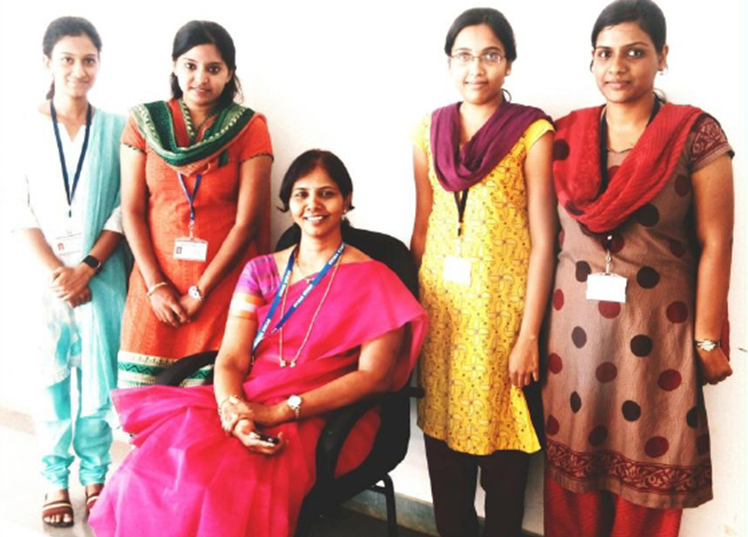
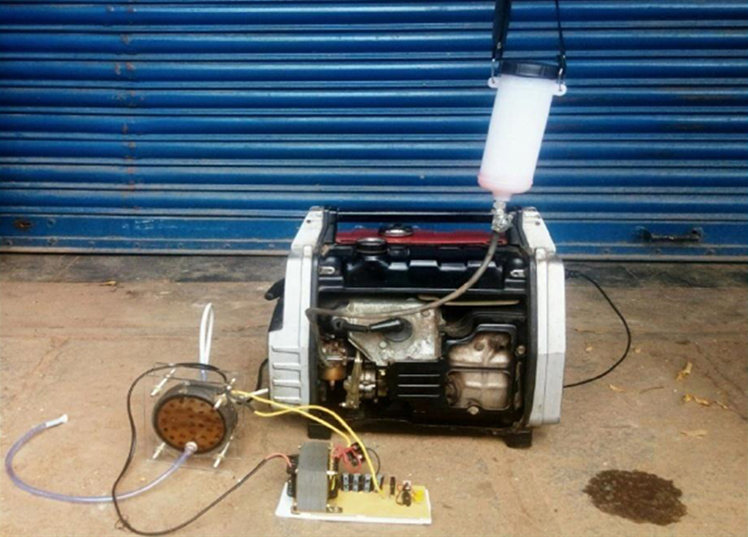
Team Members : Meghana C V, Pavithra V
Project Guide : Hemanth Kumar S, Assistant Professor-Department of Electrical & Electronics Engineering
Abstract of the project:
The project is aimed at testing of electrical wiring system of Metro cars manufactured by BEML Limited. This electrical multi-wire test jig checks different types of faults in wiring system accurately reducing human error and time consumption. Study on “need for Metro” and “design and testing of Metro car” lead to the development of this new test jig. Usage of this test jig, gives better results of testing of electrical wiring of power and control circuit. This project summarizes on building of basic 8-pin test jig and its cascading to ‘n’ number of stages which can be altered according to the need and also concentrates on design of main power and control circuit of Metro car. This one test jig can used to test various faults in wiring. The test jig reduces the time for testing and this leads to more production of Metro cars.
This multi wire cable tester with a separate LED for each wire, will show open circuits, short circuits, reversals, earth faults and continuity. The circuit comprises transmitter and receiver, the cable under test linking the two. The transmitter is nothing more than a "LED chaser", the 4011 IC wired as astable and clocks a 4017 decade counter divider. The 4017 has limited driving capabilities and hence each output is buffered by a 4050 IC. This IC provides sufficient current boost for long cables and the transmitter and receiver LED's. The receiver is simply LED's with a common wire.
During the detailed study on Metro car electrical wiring system, it was found that the conventional method of “Bell check” test of electrical wiring was employed, which was done manually and it was imperfect. This resulted in severe damage of electrical equipment and financial loss to the company. To overcome this problem which was encountered in conventional method, modern testing equipment is incorporated. This is “Multi-wire automatic continuity test jig”.
Cost of the project: Rs 2,000 /-
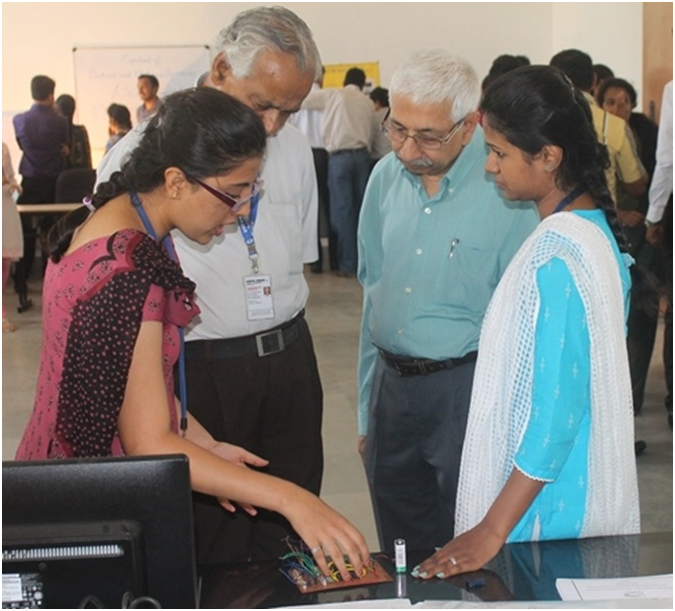
Team Members : Abhishek K V, Bharath Raj R, Chethan Kumar T, Kartheek A S
Project Guide : P.S.Kiran Kumar, Assistant Professor-Department of Electrical & Electronics Engineering
Abstract of the project:
The safe production level of coal mine is still low, especially in recent years, disasters of coal mine occur frequently, which lead to great loss of possession and life, the safety problems of coal mine has gradually become to the focus that the nation and society concern on.
The disasters in coal mining is due to the complexity of mine environment and the variety of work condition of coal mine, so it is very necessary to monitor mine working environment. The various environmental parameters of mine safety monitoring and controlling system, such as methane, carbon monoxide, temperature, oxygen and so on, are currently using the traditional cable transmission. Thus truly mine methane; carbon monoxide gas such as the dead gob cable security parameters cannot be monitored, so they cannot predict the alarm.
A variety of products for the current diversity of coal mine safety and underground coal mining process variability space, mine safety wireless network should be compatible with existing mine safety system with data transmission functions, has good flexibility, scalability, self- set of network capabilities. As the mine has its own special applications require a simple sensor network protocols, network easy, self-organization, self-healing ability.
ZigBee is a wireless communications technology, with a short distance, safe and reliable, we can use ZigBee technology to collect the various parameters of the terminal transmitted to the sensor on the tunnel gateway, and then data transmission to the ground central control computer, by computer analysis and comparison of the data in order to assess the security situation in the Mine.
An agent-based wireless local positioning system with ZigBee technology is proposed, mainly for factory level applications. A cost effective ZigBee-based wireless mine supervising system with early-warning intelligence on methane, temperature, humidity in mining area. Wireless sensor networks applied in monitoring coal mine security breaks through the traditional methods and ideas, which improves the practical ability and flexibility of monitoring system.
An agent-based wireless local positioning system with ZigBee technology is proposed, mainly for factory level applications. A cost effective ZigBee-based wireless mine supervising system with early-warning intelligence on methane, temperature, humidity in mining area. Wireless sensor networks applied in monitoring coal mine security breaks through the traditional methods and ideas, which improves the practical ability and flexibility of monitoring system.
Cost of the project: Rs 14,000 /-
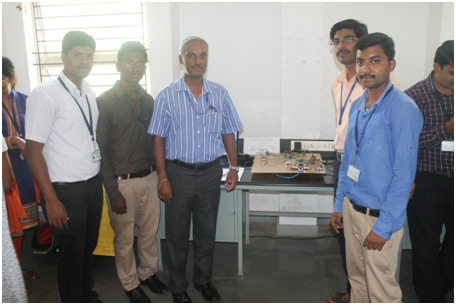
Team Members : Ms. Deepthi Rai, Mr. Karthik B G, Ms. Mahalakshmi S, Mr. Vinayaka S
Project Guide :Shakunthala C, Assistant Professor-Department of Electrical & Electronics Engineering
Abstract of the project:
Quad copter unmanned aerial vehicles are used for surveillance and reconnaissance by military and law enforcement agencies, as well as search and rescue missions in urban environments. Quad copter or quad rotor aircraft is one of the UAV that are major focuses of active research in recent years. Compare to terrestrial mobile robot that often possible to limit the model to kinematics, quad copter required dynamics in order to account for gravity effect and aerodynamic forces. Quad copter operated by thrust that produce by four motors that attached to it body. It has four input force and six output states and it is an under actuated system, since this enable quad copter to carry more load. Quad copter has advantages over the conventional helicopter where the mechanical design is simpler. Besides that, quad copter changes direction by manipulating the individual propeller’s speed and does not require cyclic and collective pitch control. The navy’s mad scientists put out a bit of info about a new program to teach drones to hunt mines. It’s both super clever and, in retrospect, why-didn’t-I-think-of-that obvious. Take one cheap, commercially available quad copter drone, add two very sensitive metal detectors, engineer it up, and presto-a mine-hunting drone perhaps have heard of drone swarms, the business of getting individual drones to fly together in coordinated formations to perform all manner of tasks. Since drones can be made to move in flocks, instead of one drone slowly sweeping a few feet of water at a time, the navy could use tens or hundreds or thousands of drones to cover huge areas in no time flat.
The Unmanned Aerial Vehicle is designed and tested by flying using remote controller. UAV is controlled up to 30-40m range of distance and metal sensor circuit can sense the metal or ore particles present in the particular piece of land. The metal sensor can detect metal or ore from a distance of 5-6cm range. The problem of detecting ore in land manually is eliminated by using metal sensor fitted to quadcopter. The remote places which cannot be reached by humans are tested using metal sensors fitted to quadcopter. The disadvantage of conventional method of searching ore for mining is eliminated. Geographical mapping may not be appropriate since it is a assumption of geologists but searching of mining using metal sensor is practical and mines are detected accurately in a piece of land.
Military Applications.
- Unmanned vehicles fitted with metal sensor can be used for searching mines which is very difficult to detect manually in war fields and in border.
- It can also be used to detect anti-social activities which take place underground which are very difficult to detect manually
- Unmanned Vehicle is used to collect water from lakes or river for drinking purpose for soldiers in war fields and borders.
- It can also be used for security purpose during day as well as night time.
Agricultural Application.
- Unmanned vehicle can be used to sow seeds in farm fields. one can sit at a place and operate uv to sow the seeds efficiently.
- Can also be used to spray the fertilizers required for the seeds which are harmful for humans when come in contact with those fertilizers.
Cost of the project: Rs 6,000 /-
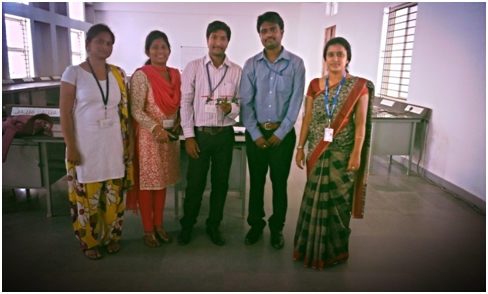
Team Members : Roshan Gerald.V, Chandini T.I, Harshitha, Sneha G
Project Guide : Miss. SUSHMA H.S, Assistant Professor-Department of Electrical & Electronics Engineering
Abstract of the project:
The trains are moderate vehicles used for transporting people and goods. Mostly, the people prefer the train journey for longer distance as it is cheaper. Since induction of train for public transportation, the fire accidents are not catered seriously by the Indian Railways. The notices showing "Do not smoke", "Do not carry inflammable material" are the only precautionary warnings about the fire in each compartment. However, because of failure in routine maintenance system or by the activities of illegal social elements, the fire accidents in train occur frequently. These fire accidents are among the most serious disasters to human lives and the property of government. In recent days, the train fire accident occurred and made several human loss. The prevention of train fire has become a serious concern in our country.
In present days there are so many safety measures and prevention techniques used to avoid accidents caused due to collision derailment of trains but there is no measure taken to avoid fire or extinguish fire. So our project gives you a clear picture how the fire accidents are caused due to RMPU, avoid the problems which are occurring presently in the RMPU and to extinguish fire if occurs.
The simulation based project “preventing fire accidents in train using PLC & SCADA.” has the advantages of SCADA & PLC. PLC is used for automation and SCADA for control and monitoring. This project ensures less maintenance and reduces risk factor and also increases the efficiency. Now a day’s PLC and SCADA plays the important role in automation devices. In our project we are going to utilize the application of PLC and SCADA effectively to prevent fire accidents and save life of people.
The project mainly concentrating on fire accidents which are a major issue which railway is currently facing. In our project we are focusing on the prevention of the fire accidents using a advance automation technology called PLC & SCADA in simulation based project.
Cost of the project: Rs 12,000 /-
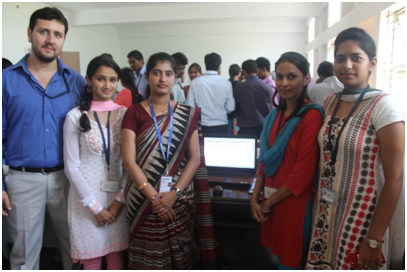
Team Members : James Emmanuel, Laharishree Y, Mahendra G, Jahnavi V M
Project Guide : Smt. Sowmya G, Assistant Professor-Department of Electrical & Electronics Engineering
Abstract of the project:
This project work describes an effective solution to the electrical accidents occurring due to broken transmission lines. It provides a value addition to the existing Power Transmission and Distribution system by introducing an Automatic Detection and Cut-off System, thereby preventing fatal electrical accidents due to wire breaks and live wires hanging by the pole. This work describes a cost efficient method to cut-off the power supply in the broken part of the transmission line thereby saving the lives. It is based on the Radio Frequency Communication between the modules mounted at both the ends of the electric pole. Communication between the modules exists until there is no physical breakage in the wire. In case of breakage of the transmission line, the communication between the modules stops and the microcontroller asserts a signal to actuate the circuit breaker. Due to the actuation of the circuit breaker, power is cut off in the broken transmission line, thereby preventing electrocution of humans and animals hence saving their precious lives.
Provides a solution and it’s a cost efficient module which is purely automated and can be implemented. The module uses simple technology of RF Module and Circuit Breaker and provides a modular approach.
Cost of the project: Rs 7,000 /-

Team Members : Supreeth, Sunilkumar, Madhumathi, Sindhu
Project Guide : Sri Chandrashekar P, Assistant Professor
Abstract of the project:
The main theme of this project is utilization of industrial waste emerging out through chimneys in the form of heat. The principle used is “Bottoming cycle”. The excess heat from a manufacturing process is used to generate steam, and this steam is used to generate electricity. No extra fuel is required to produce electricity, as fuel is already burnt in production process.
The main aim of this project is to generate electricity locally available resource to utilize for local areas. Even though large amount of power cannot be generated, its ample enough to run lighting system which reduces the energy consumption significantly.
This work also helps the end users and also low load consumers. Usually due to large power demand in industries bulk amount of power is supplied to them ignoring low load users. So to overcome this imbalance it is necessary that the industries generate power locally through various resources available within.
The project aims to generate power only using the already available resources and renewable sources. Since there is no combustion of fuel, it is eco-friendly and does not pose any threat to the environment
To conclude that by installing this project work in large industries the power demand can be decreased significantly and also end and low load consumers get ample power for their use.
Cost of the project: Rs.7,000/-
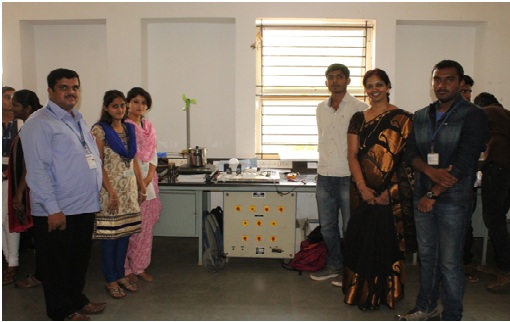
Team Members : Smitha S M, Vikas S
Project Guide :Smt. Shakunthala C , Assistant Professor Dept. of Electrical & Electronics Engineering
Abstract of the project:
Fossil fuels are the main resources for the generation of electricity, which have been considered as major contributors to environmental problems. One potential alternative to explore is the use of microbial fuel cells (MFCs), which generate electricity using microorganisms. Microbial fuel cells (MFCs) employ microbes to generate electricity from biochemical energy produced during metabolism of organic substrates. MFC consists of anode and cathode connected by an external circuit and separated by proton exchange membrane (PEM). In anode chamber, decomposition of organic substrates by microbes generates electrons (e-) and protons (H+) that are transferred to cathode through the circuit and membrane, respectively. Organic substrates are utilized by microbes as their energy sources, outcome of this process is the release of high-energy electrons which transferred to electron acceptors (molecular oxygen). In a double-chamber microbial fuel cell (DC-MFC) the voltage and power production increased by using a mixed culture rather than a pure culture under continuous mode of operation In the present experimental study wastewaters were used as substrate, which were collected from MYMUL NANDINI DIARY, Nazarbad, Mysore, India and JSS Hospital, Near Agrahara, Mysore, India. Double chamber MFCs were fabricated using acrylic plexi-glass and electrodes such as, carbon brush and carbon rod electrodes were used. Curd, pond sediment (PS) and rice field soil (RFS) were used as inoculum. Constructions of MFCs were found to be low cost with agar salt bridge when compared with Nafion membranes. In the order to increase electron transfer, mediators such as, potassium permanganate and phosphate buffer were used. The results of Characterization of Hospital and Diary wastewaters showed for COD concentration that the wastewater falls under medium and high strength wastewaters, which found to be ideal to generate power from DC-MFC reactor. The maximum voltage and current obtained from Hospital wastewater as a substrate and the microbes present in sludge, glucose were found to be 825 mV and 2.1 mA, Respectively. Experiments were also conducted using Diary wastewater, with glucoseand sludge as energy source for microbes, which yielded a maximum voltage of 1000 mV and current of 4.5 mA.Higher COD concentrations of wastewaters were found to yield greater current production. Hence, dilution of wastewater resulted in lower current production.
Cost of the project: Only for Electrodes Cost i.e., Rs. 1000/- only
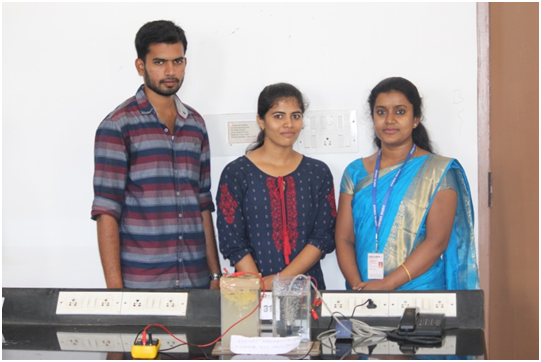
Team Members : Nandeesh T, Harsha R M, Praveen M, Sangeetha T
Project Guide : Smt Sheila H, Associate Professor Dept. of Electrical & Electronics Engineering
Abstract of the project:
The telemetry based project is about detecting the moisture in the soil and then monitoring it using a water pump. The main objective of this project is to maintain the moisture of soil so that it does not affect the crops. Soil moisture sensors typically refer to sensors that estimatevolumetric water content. Measuring soil moisture is important for agricultural applications to help farmers managetheir irrigation systems more efficiently. Knowing the exact soil moisture conditions on theirfields, not only are farmers able to generally use less water to grow a crop, they are also able toincrease yields and the quality of the crop by improved management of soil moisture duringcritical plant growth stages. In urban and suburban areas, landscapes and residential lawns areusing soil moisture sensors to interface with an irrigation controller. Connecting a soil moisturesensor to a simple irrigation clock will convert it into a "smart" irrigation controller that preventsirrigation cycles when the soil is already wet, e.g. following a recent rainfall event.
The Internet of Things (IOT, sometimes Internet of Everything) is the network of physical objects or "things" embedded with electronics, software, sensors, and connectivity to enable objects to exchange data with the manufacturer, operator and/or other connected devices based on the structure of International Telecommunication Union's Global Standards Initiative.
Cost of the project: Rs 17,000 /-
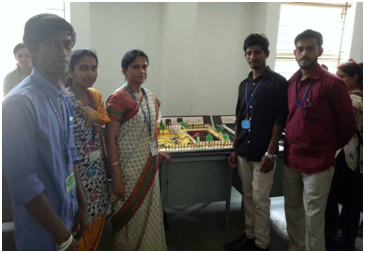
Team Members : Mohan Aradhya A R, Kiran Kumar H S, Chethan C, Rakshitha M J
Project Guide : Smt.Shamala N, Associate Professor Dept. of Electrical & Electronics Engineering
Abstract of the project:
Considering the present situation, usage of plastic is in high extent. As the cities get modernized, usage of plastic has also increased and it has become a major problem for our environment.Plastic is a waste which is non biodegradable. It is a long lasting waste which cannot be cleared even after many years of usage. Here, there is a solution from this project“plastic as a fuel” by which we can convert the daily used plastic as a fuel.
The daily used plastic is collected from number of sources and dumped at the container. Others are doubtful of the conversion process and have concerns about pollution or toxic residue .but the machine actually uses highly efficient but pretty straight forward pyrolysis. The plastic fed into the pressurized oxygen-free oven and heated to 350 degree centigrade which liquefies it. Then liquefied plastic is converted to gas, which condenses to form a crude oil mixture of gasoline, diesel, kerosene and heavy oil. There is no toxic substances produced and the small amount of inert residue that may be left over and disposed to garbage.
Cost of the project: Rs 12,000 /-
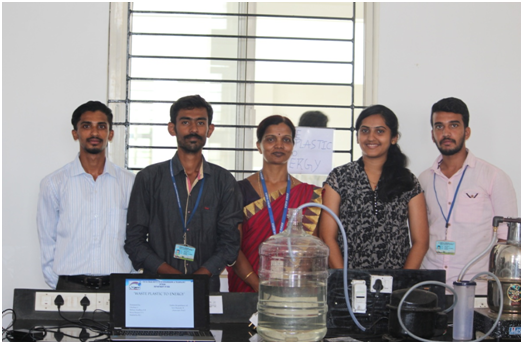
Team Members : Arpitha M J, Mahalakshmi B A, Lavanya R, Lavanya D C
Project Guide :Mrs Varsha V, Assistant Professor Dept. of Electrical & Electronics Engineering
Abstract of the project:
The main objective of this project is to monitor the dustbin and maintain the environment smart and clean. Nowadays people are using more products including food items, industrial products, medicines and, plastic materials. After expiry of these items they are put it into a dustbin for disposal. Without proper maintenance of dustbins, these expiry items can create epidemic diseases among people and pollution to the ambience. So the dustbins at cities, home, industries and hospitals have to be maintained properly to ensure cleanliness. This paper presents an Arduino based smart dustbin monitoring system which can be operated using a GSM. The Arduino Uno controller is used to read the dustbin levels with the help of Ultrasonic sensor. After 100% filling of dust and waste items, vehicle is sent to that area to collect the garbage deposited. Arduino Uno contains Atmega328p-pu IC. Arduino Ethernet shield is used to send the data to server in order to monitor the dustbin level. Embedded C is used to program the controller and GSM SIM300 is employed for creating the message.
GSM and for truck monitoring system The proposed system would be able to monitor the solid waste collection process and management the overall collection process. This technique would provide solid waste collection in time and also overcome all the disadvantages which are as use of minimum route, low fuel use, clean and green environment and available vehicle. The technologies which are used in the proposed system are good enough to ensure the practical and perfect for solid waste collection process monitoring and management for green environment
Cost of the project: Rs. 2,100/- only
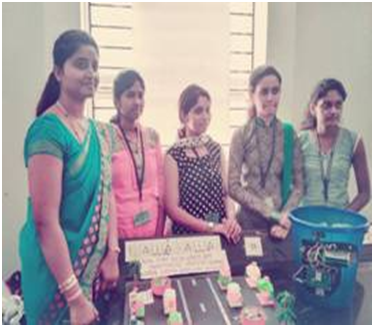
Team Members : Divyashree R N ,Nandeesh, Gayathri L, Manjusri H K
Project Guide : Hemanth Kumar S, Assistant Professor Dept. of Electrical & Electronics Engineering
Abstract of the project:
The health hazards in the present era are increased to a greater extent. The people with different age groups are the victims. The ambulance service has assisted 29.4 lakh people in various health emergencies like respiratory problems, cardiac disorders, pregnancies, suicide, accidents and many others. The loss of human life must be avoided.According to statistical data, per day 40% of peoples were died in India due to the ambulance delay. Our Indian roads are not ambulance friendly andtraffic congestion is the major facts that cause delayto ambulance especially during peak hours. The ambulance to reach the hospital in time to minimize the victims death we have taken a project called “SMART LIFE SAVER WITH AUTOMATIC TRAFFIC CONTROL”.
Here we are tracking the health parameters of the victims such as body temperature, heart rate in the ambulance, these parameters are measured using a different sensors such as LM35, L14F1 respectively and the measured parameters are interfaced with the arduino and it is sent to the hospital by using GSM Trans receiver, which is interfaced by MAX 232, so that doctor can give treatment to the victim as early as possible, It is one of the major part of our project. In the other hand we provide 4 switches for driver for 4 different lanes. The driver will see from which lane he is going and will press appropriate button it will send a 4 bit data to the signaling unit through HT12E, TX433 Radio Frequency transmitter. This can be done 30 feet before the signal unit it make all other lane signal into red other than the lane where ambulance is present. Once it ambulance is 30 feet away from the signaling unit the signal will come back to its normal state.
Cost of the project: Rs. 7,000/- only
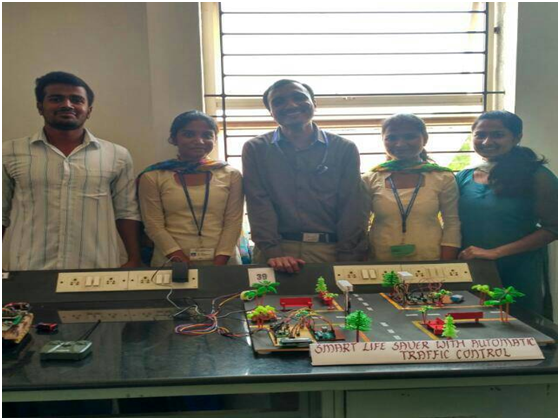
Team Members : Divyashree R N ,Nandeesh, Gayathri L, Manjusri H K
Project Guide : Hemanth Kumar S, Assistant Professor Dept. of Electrical & Electronics Engineering
Abstract of the project:
In the growing population, the problem faced by the people is pollution. Air pollution slashes life expectancy by 3.2 years for the 660 million Indians who live in cities, including Delhi. In China, the corresponding dip is marginally lower at three years. India being a developing country, the major cities in India is turning to the concrete cities. Now a day’s human is depending on vehicles by one or the other means. Due to this the air pollution in the cities are globally increasing. It adversely affects the environment and also the human being. The most important thing is that the children are mainly affected by the air pollution. Children exposure to air pollution is a special concern because their immune system and lungs are not fully developed when exposure begins, raising the possibility of different responses than seen in adults. In addition, children spend more time outside, where the concentrations of pollution from traffic, power plants, and other combustion sources are generally higher. Children breathe more air per pound of body weight, so their exposure to air pollution is much greater than adults. Children organs, including their lungs, develop until they reach their late teens, usually around the age of 18. In India one survey estimated that about 35% of children are suffering from respiratory problem due to air pollution.
Although air pollution has long been thought to exacerbate minor acute illnesses, recent studies have suggested that air pollution, particularly traffic-related pollution, is associated with infant mortality and the development of asthma and atopy. Other studies have associated particulate air pollution with acute bronchitis in children and demonstrated that rates of bronchitis and chronic cough declined in areas where particle concentrations have fallen. Other victims of this air pollution are the old people whose respiratory system is not strong to withstand the pollution of the world's top 20 polluted cities, 13 are in India compared to just three in China.
Today’s children are tomorrow citizens. It’s our responsibility to take care of children health. Hence the pollution could be control to required level and keep the surroundings to be pollution free zone. For this intension, our project title called „SMART POLLUTION FREE ZONE ‟.
Cost of the project: Rs. 8,000/- only
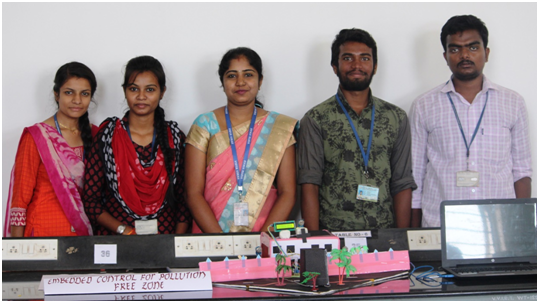
Team Members :Mohammed Anees , Mohammed Azharuddin , Prashanth T.N , Lohith A.N
Project Guide : SMT. Swathi.K , Assistant Professor Dept. of Electrical & Electronics Engineering
Abstract of the project:
The present project “Women Self Defense by Electric Shock System” aims at providing security during emergency situations by including GPS(the location where the victim is in) and GSM(sends message to nearby police stations or family members).Normally in emergency situations a person presses an emergency key So whenever an emergency key is pressed the ALARM gets activated for a specified duration and later the system will take GPS points (the location where victim is in terms of latitude and longitude) and it will send it to the family members through GSM and as well as the nearby police station and necessary actions will be taken. Meanwhile the victim can use electric shock system to prevent the accused.
The system allows for knowing exact location of the individual, as soon as the trigger key on the belt is pressed. By providing the instant location of the distressed victim to the police so that the incident could be prevented and the culprit apprehended. In case if the caretaker wants to know the present location of the lady, he/she can do so by sending a SMS to the SIM number of the lady which contains a secret password. Women’s security is a critical and social issue in today’s world. The crime (molestations, robbery, sexual assault, rape, domestic violence) against the women can be now brought to an end with the help of real system implementation of propose module. The concept can be used to provide the security for Physically Challenged Girls by adopting voice recognition kit. It can be used in the military applications to track the soldiers. The device can be used in the adventure related events.Our innovation is helpful in saving women from harassment. In India lots of crimes happens against women every day.
Cost of the project: Rs. 13,000/- only
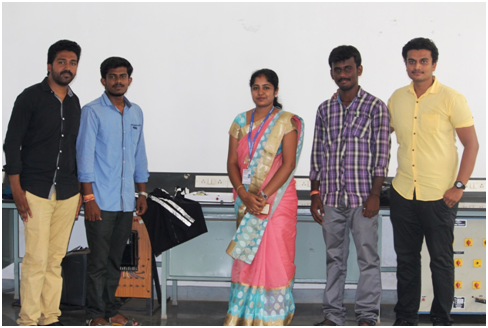
Take a short tour in our campus